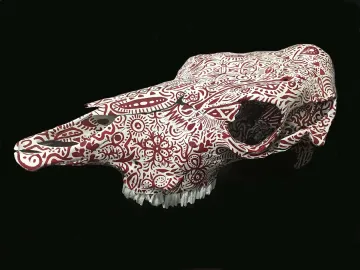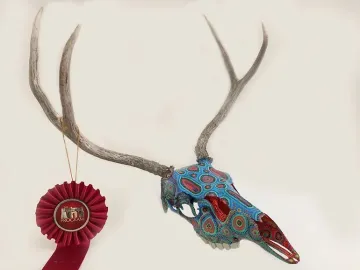Staff Spotlight: Ramona Walls, Living in a World of Art and Science
CyVerse science informatician Ramona Walls' career has spanned fashion design, ecology, and ontology, and art. She finds her award-winning artwork complementary to her scientific side.

Ramona Walls is a CyVerse science informatician specializing in biodiversity informatics and data management at CyVerse headquarters at the University of Arizona. Walls’ painted skulls took first place in 2018 and second place in 2017 in the University of Arizona’s On Our Own Time staff art show and competition. On Our Own Time is sponsored by The National Arts Program.

Walls explains how her artistic and scientific journeys have developed together.
When did your interest in science begin?
“When I was 17 I went to Carnegie Mellon University as a physics major. Then I changed my major to chemistry, and then I changed my major to professional writing, and then my dad said I should take some time off and decide what to do with my life.”
What did you decide to do?
“I decided I wanted to become a fashion designer! I moved to New York City and got an Associate’s Degree in Apparel Design at the Fashion Institute of Technology.”
Your fashion design career took you from New York City to The Netherlands to Germany over the course of about 10 years. What brought you back to science?
“I wanted to go back to school to study horticulture, but then discovered something called ecology that I didn’t know existed before. I was the valedictorian with a 4.0 in Environmental Resource Management with a minor in Horticulture from Penn State, but had no interest in graduate school. Then I remember sitting in a field looking at plants, and I thought ‘people will pay me to do this?!’ I went on to the University of Pittsburgh, eventually transferred to Stony Brook University, and got my Ph.D. in Ecology and Evolution studying the evolutionary eco-physiology of wild yams in Mexico.”

How did you come to CyVerse?
“I was introduced to data integration at Stony Brook, and to me the interdisciplinary part of research was the most interesting. I found a postdoc at the New York Botanical Garden as the developer of Plant Ontology. At first, I didn’t know what ontology was (it’s the structured description of a domain that lets computers understand data) but it turned out that I loved it, and that’s how I transitioned from doing basic research to doing more bioinformatics.
I saw that CyVerse, which was then called the iPlant Collaborative, was looking for a researcher in ecological informatics. I especially love working with other researchers to help solve challenges, and I thought it would be a really good fit for me.”
How does your interest in art complement your interest in science?
“When I left fashion design and got into science, the thing that was the hardest for me was that science is all about postponement of gratification. You work really hard and then in about six years you get an answer to your question, and then in 20 years your answer might be useful for something. I really missed how in fashion design I would do something and at the end of the day I would have a product. Artwork lets me do that.”
Do you have a life philosophy?
“I consider myself a very materialistic person in the sense that I don’t believe in an afterlife. I believe that this material world is the world that we get, so my life gets a lot of meaning from my senses, from touch and smell and sound, looking at colors, and just experiencing the world around me. My scientific work is aimed at mechanistically understanding the world, whereas my artistic work is aimed at emotionally expressing my love for it.”

Tell me about the painted skulls. What do they mean to you?
“When I moved in with my husband, he had this old cow skull that he’d picked up in Texas. I’d look at it and think ‘I need to paint that.’ I was really inspired early on by Oaxacan painted wood carvings and Aboriginal art from Australia. Since then, I have found other skulls and objects that call out to me to be painted.’
I don’t really care if the skull is pristine or in good shape. I like working with natural shapes and complementing them with paint. When I paint these bones I’m not only thinking about the artistic form of the bones, but, as someone who eats animals, I think it’s important to appreciate the sacrifice that animals give in order to feed me.”
Walls’ artwork will be displayed at omnivoresgratitude.com. She is willing to sell the art and takes commissions and invites anyone interested in her artwork to contact her at omnivoresgratitude@gmail.com

